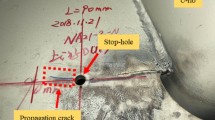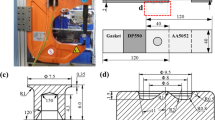Abstract
To solve the problems of low-strength and unsatisfactory connection quality in the plastic clinching of heterogeneous lightweight materials for car bodies, Q235 steel sheets and 5052 aluminum alloy sheets were selected as research objects. An inclined wall die for plastic clinching was designed on the basis of the deformation and flow characteristics of sheets in the plastic clinching process. Elastic–plastic finite element numerical simulation and experimental research were conducted to analyze the plastic clinching process of the inclined wall die, and the failure mode and mechanism of the clinching joints in the shear and peel experiment were comprehensively studied. Results showed that the inclined wall die can effectively increase the interlock value of the joints and reduce the maximum joining force during the clinching process under the condition of ensuring the neck thickness of the joints. When the inclined wall angle α increased from 90° to 100°, the interlock value increased by 38.9%, and the maximum joining force decreased by 8.3%. The influence of the inclined wall structure on joint quality can be divided into the extrusion, radial inflow, and stability stages. The comparison between the clinching experiment and the finite element results showed that the results are in good agreement, proving that the finite element model of the plastic clinching of the inclined wall die exhibits a high degree of credibility and verifying the feasibility of the practical application of the inclined wall die. Finally, the major failure mode of the joints under shear and peel loads was separation failure.














Similar content being viewed by others
Availability of data and materials
Not applicable.
References
Deepati AK, Alhazmi W, Benjeer I (2021) Mechanical characterization of AA5083 aluminum alloy welded using resistance spot welding for the lightweight automobile body fabrication. Mater Today Proc 45:5139–5148. https://doi.org/10.1016/j.matpr.2021.01.646
Chu YT, Sun LY, Li LJ (2019) Lightweight scheme selection for automotive safety structures using a quantifiable multi-objective approach. J Clean Prod 241:118316. https://doi.org/10.1016/j.jclepro.2019.118316
Hirsch J (2011) Aluminium in innovative light-weight car design. Mater Trans 52(5):818–824. https://doi.org/10.2320/matertrans.L-MZ201132
Li H, Yan ZH, Cao LY (2018) Bake hardening behavior and precipitation kinetic of a novel Al-Mg-Si-Cu aluminum alloy for lightweight automotive body. Mater Sci Eng, A 728:88–94. https://doi.org/10.1016/j.msea.2018.05.014
Lambiase F, Di Ilio A (2014) An experimental study on clinched joints realized with different dies. Thin-Walled Struct 85:71–80. https://doi.org/10.1016/j.tws.2014.08.004
Lambiase F, Ko DC (2017) Two-steps clinching of aluminum and carbon fiber reinforced polymer sheets. Compos Struct 164:180–188. https://doi.org/10.1016/j.compstruct.2016.12.072
Chen C, Zhao SD, Cui MC, Han XL, Zhao XZ, Fan SQ (2017) Study on the flat-reshaping technology with no rivet for joining aluminium alloy sheet of the automobile. J Mech Eng 53(18):42–48. https://doi.org/10.3901/JME.2017.18.042
Chen C, Ouyang YW, Qin DL (2021) Finite element analysis of material flow in flat-rivet clinching process. Int J Adv Manuf Technol 116:1961–1974. https://doi.org/10.1007/s00170-021-07532-2
Lee CJ, Lee JM, Ryu HY, Lee KH, Kim BM, Ko DC (2014) Design of hole-clinching process for joining of dissimilar materials-Al6061-T4 alloy with DP780 steel, hot-pressed 22MnB5 steel, and carbon fiber reinforced plastic. J Mater Process Technol 214:2169–2178. https://doi.org/10.1016/j.jmatprotec.2014.03.032
Lee CJ, Kim BM, Kang BS, Song WJ, Ko DC (2017) Improvement of joinability in a hole clinching process with aluminum alloy and carbon fiber reinforced plastic using a spring die. Compos Struct 173:58–69. https://doi.org/10.1016/j.compstruct.2017.04.010
Lin PC, Lin JW, Li GX (2018) Clinching process for aluminum alloy and carbon fiber-reinforced thermoplastic sheets. Int J Adv Manuf Technol 97:529–541. https://doi.org/10.1007/s00170-018-1960-7
He XC, Zhang Y, Xing BY, Gu FS, Ball A (2015) Mechanical properties of extensible die clinched joints in titanium sheet materials. Mater Des 71:26–35. https://doi.org/10.1016/j.matdes.2015.01.005
Zhang Y, He S, Yang L, Guo J, Luo Z, Ma CY (2017) Joining aluminum alloy 5052 sheets via novel hybrid resistance spot clinching process. Mater Des 118:36–43. https://doi.org/10.1016/j.matdes.2017.01.017
Busse S, Merklein M, Roll K, Ruther M, Zürn M (2010) Development of a mechanical joining process for automotive body-in-white production. Int J Mater Form 3(1):1059–1062. https://doi.org/10.1007/s12289-010-0953-3
Eshtayeh M, Hrairi M (2016) Multi objective optimization of clinching joints quality using Grey-based Taguchi method. Int J Adv Manuf Technol 87:233–249. https://doi.org/10.1007/s00170-016-8471-1
Varis JP (2002) The suitability of round clinching tools for high strength structural steel. Thin-Walled Struct 40:225–238. https://doi.org/10.1016/S0263-8231(01)00063-5
Varis JP (2003) The suitability of clinching as a joining method for high-strength structural steel. J Mater Process Technol 132:242–249. https://doi.org/10.1016/S0924-0136(02)00933-0
Lei L, He XC, Zhao DS, Zhang Y, Gu FS, Ball A (2018) Clinch-bonded hybrid joining for similar and dissimilar copper alloy, aluminium alloy and galvanised steel sheets. Thin-Walled Struct 131:393–403. https://doi.org/10.1016/j.tws.2018.07.017
Song YL, Yang LL, Zhu GP, Hua L, Liu RZ (2019) Numerical and experimental study on failure behavior of steel-aluminium mechanical clinched joints under multiple test conditions. Int J Lightweight Mater Manuf 2:72–79. https://doi.org/10.1016/j.ijlmm.2018.12.005
Xu F, Zhao SD, Cai J, Han XL (2014) The experimental analysis of shear strength of round joints. Proc Inst Mech Eng B J Eng Manuf 228:1280–1289. https://doi.org/10.1177/0954405413517672
Zhao L, He XC, Xing BY, Lu Y, Gu FS, Ball A (2015) Influence of sheet thickness on fatigue behavior and fretting of self-piercing riveted joints in aluminum alloy 5052. Mater Des 87:1010–1017. https://doi.org/10.1016/j.matdes.2015.08.121
Lin PC, Fang JC, Lin JW, Tran XV, Ching YC (2020) Preheated (heat-assisted) clinching process for Al/CFRP cross-tension specimens. Materials 13:4170. https://doi.org/10.3390/ma13184170
Chen YW, Li MJ, Yang XJ, Wei K (2020) Durability and mechanical behavior of CFRP/Al structural joints in accelerated cyclic corrosion environments. Int J Adhes Adhes 102:102695. https://doi.org/10.1016/j.ijadhadh.2020.102695
Funding
This research work is supported by the Project of International Scientific and Technological Innovation Cooperation (Grant No. 2021YFH0031).
Author information
Authors and Affiliations
Contributions
Menghan Wang conceived and designed the experiments; Yifeng Chen and Yan Han performed the experiments; Lei Li and Menglong Du analyzed the data; Yifeng Chen and Yan Han wrote the paper.
Corresponding author
Ethics declarations
Consent to participate
All authors agreed with the consent to participate.
Consent for publication
All authors have read and agreed to the published version of the manuscript.
Conflict of interest
The authors declare no competing interests.
Additional information
Publisher's Note
Springer Nature remains neutral with regard to jurisdictional claims in published maps and institutional affiliations.
Supplementary Information
Below is the link to the electronic supplementary material.
Rights and permissions
About this article
Cite this article
Wang, M., Chen, Y., Han, Y. et al. Steel-aluminum plastic clinching of an inclined wall die. Int J Adv Manuf Technol 121, 6243–6253 (2022). https://doi.org/10.1007/s00170-022-09707-x
Received:
Accepted:
Published:
Issue Date:
DOI: https://doi.org/10.1007/s00170-022-09707-x




